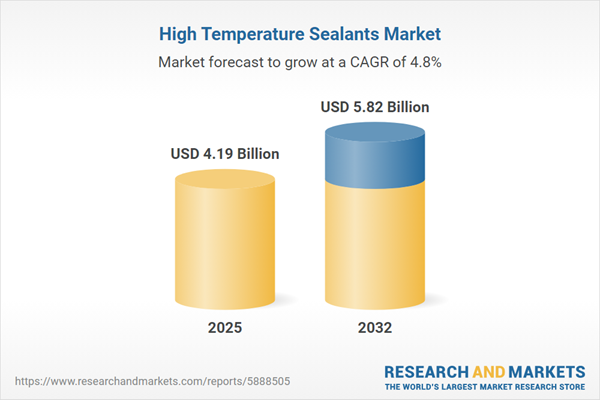Speak directly to the analyst to clarify any post sales queries you may have.
High temperature sealants play a crucial role in modern manufacturing and infrastructure, providing essential performance in demanding environments where thermal, chemical, and mechanical reliability are paramount. Their adoption spans industries seeking to maximize operational resilience and streamline processes for long-term efficiency.
Market Snapshot: High Temperature Sealants Market
The high temperature sealants market is experiencing steady expansion, with revenues increasing from USD 4.00 billion in 2024 to USD 4.19 billion in 2025. With a compound annual growth rate (CAGR) of 4.81%, projections indicate the market will reach USD 5.82 billion by 2032. Growth is driven by rising demand for materials capable of withstanding challenging thermal and chemical stress within critical industries such as aerospace, automotive, electronics, and energy.
Scope & Segmentation
This report provides a detailed examination of the high temperature sealants sector, encompassing the following segments and regions:
- Chemistry Types: Acrylic, one-component epoxy, two-component epoxy, hybrid, polyurethane, silicone (including HTV, one-component RTV, two-component RTV)
- Form Factors: Film, liquid (bulk and cartridge), paste (bulk, cartridge, tube), tape
- Applications: Aerospace, automotive, construction, electronics, industrial
- End Users: OEM, aftermarket
- Sales Channels: Direct, distributors, online
- Regional Coverage: Americas (United States, Canada, Mexico, Brazil, Argentina, Chile, Colombia, Peru), Europe, Middle East & Africa (United Kingdom, Germany, France, Russia, Italy, Spain, Netherlands, Sweden, Poland, Switzerland, United Arab Emirates, Saudi Arabia, Qatar, Turkey, Israel, South Africa, Nigeria, Egypt, Kenya), Asia-Pacific (China, India, Japan, Australia, South Korea, Indonesia, Thailand, Malaysia, Singapore, Taiwan)
- Leading Companies: 3M Company, Dow Inc., Henkel AG & Co. KGaA, Sika AG, H.B. Fuller Company, Wacker Chemie AG, LORD Corporation, RPM International Inc., Pidilite Industries Limited, Ashland Global Holdings Inc.
Key Takeaways for Senior Decision Makers
- Advanced high temperature sealants enable critical engineering assemblies to perform reliably under severe operational conditions, directly supporting uptime and safety mandates across sectors.
- Industry innovation focuses on material science breakthroughs, such as hybrid chemistries and environmentally responsible solutions that meet evolving sustainability standards and global regulations.
- Digital manufacturing trends enhance sealant deployment, allowing efficient application accuracy, predictive maintenance, and reduced waste in fast-paced production settings.
- Regional adoption patterns vary; aerospace and energy drive demand in the Americas, automotive and infrastructure push growth in Europe, while Asia-Pacific benefits from electronics and rapid industrialization.
- Strong supplier partnerships, local production strategies, and application-specific formulations are increasingly vital in managing supply chain continuity and ensuring quality in complex, global environments.
Tariff Impact and Strategic Responses
The United States has implemented tariff changes, creating pressure on cost structures and prompting market participants to reevaluate procurement strategies. Both manufacturers and end users are adopting risk mitigation measures, including nearshoring, local sourcing, and revised contractual terms to safeguard margin stability and reduce operational disruption. Investments in domestic manufacturing and agile logistics are becoming central to supply chain resilience in response to these shifting trade dynamics.
Methodology & Data Sources
This report integrates extensive primary research, including interviews with material scientists and sourcing leaders, with secondary data from technical papers, patent reviews, and regulatory documents. A robust triangulation approach validates all findings across industry, segment, and regional dimensions.
Why This Report Matters
- Enables executive teams to identify emerging technology trends, risk areas, and growth opportunities within the high temperature sealants sector.
- Delivers actionable segmentation insights, supporting more precise investment, sourcing, and R&D decisions tailored to specific end-market and regulatory needs.
- Helps organizations adapt to evolving trade and sustainability requirements by providing a comprehensive view of competitive dynamics and supply chain strategies.
Conclusion
The high temperature sealants market is evolving through innovation, sustainability initiatives, and strategic supply chain adaptations. Senior leaders equipped with in-depth, actionable insights from this report are positioned to strengthen competitive advantage and drive future-ready decisions in a complex market environment.
Additional Product Information:
- Purchase of this report includes 1 year online access with quarterly updates.
- This report can be updated on request. Please contact our Customer Experience team using the Ask a Question widget on our website.
Table of Contents
3. Executive Summary
4. Market Overview
7. Cumulative Impact of Artificial Intelligence 2025
Companies Mentioned
The companies profiled in this High Temperature Sealants market report include:- 3M Company
- Dow Inc.
- Henkel AG & Co. KGaA
- Sika AG
- H.B. Fuller Company
- Wacker Chemie AG
- LORD Corporation
- RPM International Inc.
- Pidilite Industries Limited
- Ashland Global Holdings Inc.
Table Information
| Report Attribute | Details |
|---|---|
| No. of Pages | 188 |
| Published | November 2025 |
| Forecast Period | 2025 - 2032 |
| Estimated Market Value ( USD | $ 4.19 Billion |
| Forecasted Market Value ( USD | $ 5.82 Billion |
| Compound Annual Growth Rate | 4.8% |
| Regions Covered | Global |
| No. of Companies Mentioned | 11 |









